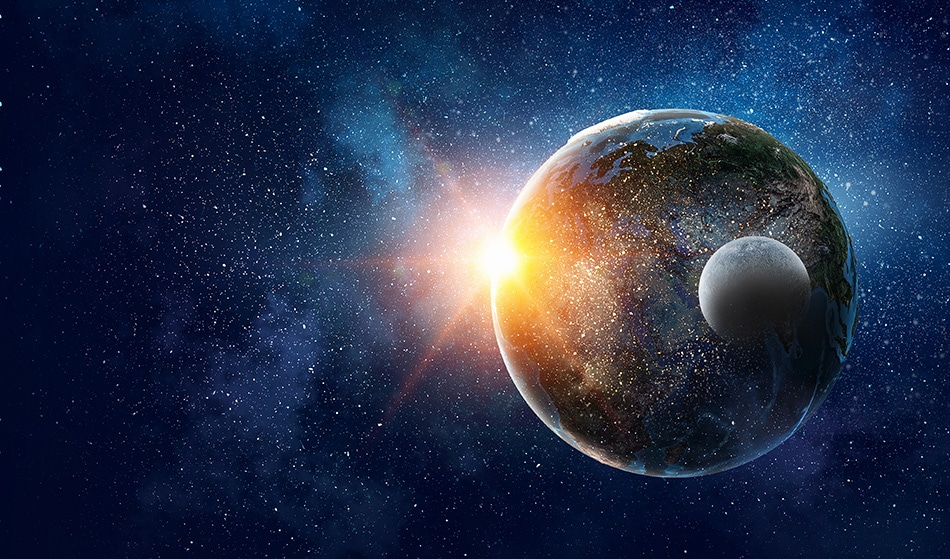Scientists at the European Southern Observatory have discovered that the planets orbiting the ultra-cool red dwarf star TRAPPIST-1 are more similar to our solar system than we thought. A new study has found that the seven known planets that orbit TRAPPIST-1 are made mostly of rock and that some might even have more water than our own planet Earth.
 Image credit: Sergey Nivens/shutterstock
Image credit: Sergey Nivens/shutterstock
The planets that surround TRAPPIST-1 are only 40 light-years from Earth, and they were first discovered in 2016 by a telescope at the La Silla European Southern Observatory (ESO). The observations were further followed in 2017 with a discovery that there were, in fact, seven planets, approximately the same size as Earth, named TRAPPIST-1b,c,d,e,f,g, and h.
The densities of the planets could have up to 5 percent of their mass as water, which is nearly 250 times more than Earth's own 0.02% water by mass. The planets closest to the parent star have a denser, steamier atmosphere, whereas the ones furthest away and have icy surfaces. The fourth planet has shown to be very similar to Earth regarding density, size, density, and radiation from the star. The fourth planet is also the rockiest planet of the seven discovered, and it has the potential to host liquid water.
Densities do not say anything about habitability. However, our study is an important step forward as we continue to explore whether these planets could support life.
Brice-Olivier Demory, Co-Author - University of Bern.
A team of scientists led by Dr. Simon Grimm at the University of Bern in Switzerland have applied very complex computer modeling methods to all the available data, and have determined the planets’ densities with a closer precision than ever previously possible.
The TRAPPIST-1 planets are so close together that they interfere with each other gravitationally, so the times when they pass in front of the star shift slightly. These shifts depend on the planets' masses, their distances, and other orbital parameters. With a computer model, we simulate the planets' orbits until the calculated transits agree with the observed values, and hence derive the planetary masses
Dr. Simon Grimm, Lead Scientist
The discovery of TRAPPIST-1 and the capabilities of ESO’s facilities in Chile and the NASA Spitzer Space Telescope in orbit have given us our first glimpse of what Earth-sized exoplanets are made of!
Eric Agol, Team Member
Each of the planets is theorized to have different densities and cores. TRAPPIST-1b and c are likely to have rocky cores and be surrounded by atmospheres much thicker than Earth's. TRAPPIST-1d is the lightest of the planets and is only 30 percent the mass of Earth. It is uncertain yet whether the mass of TRAPPIST-1d is due to a large atmosphere, ocean or ice layer. TRAPPIST-1e is the only planet in the system with a higher density than Earth, suggesting that it may have a thicker iron core and not a dense atmosphere, ocean or ice layer. TRAPPIST-1f, g, and h are so far from the host star, that water could be frozen into ice layers across their surfaces. Thin atmospheres are unlikely to contain heavy molecules, such as CO2, that are found on Earth.
It is interesting that the densest planets are not the ones that are the closest to the star, and that the colder planets cannot harbor thick atmospheres.
Caroline Dorn, Co-Author - University of Zurich, Switzerland.
Astronomers are researching into further planets around faint red stars like the TRAPPIST system, but TRAPPIST-1 continues to be the main focus. Many of the laboratory facilities on the ground and in space, including ESO’s Extremely Large Telescope and the NASA/ESA/CSA James Webb Space Telescope, have a lot more exploring to do.
Disclaimer: The views expressed here are those of the author expressed in their private capacity and do not necessarily represent the views of AZoM.com Limited T/A AZoNetwork the owner and operator of this website. This disclaimer forms part of the Terms and conditions of use of this website.